Methods of processing solutions of potassium sulfate and magnesium sulfate, methods of producing potassium sulfate, and related systems
a technology of magnesium sulfate and processing solution, applied in the field of processing solution of potassium sulfate and magnesium sulfate, methods of producing potassium sulfate, and related systems, can solve the problems of significant power and/or steam input, process limitations, and relatively slow dissolution, and achieve the effect of maximizing economic valu
- Summary
- Abstract
- Description
- Claims
- Application Information
AI Technical Summary
Benefits of technology
Problems solved by technology
Method used
Image
Examples
example 1
Mechanical Vapor Recompression with Langbeinite Recycle
[0048]A process-flow diagram and system 302 for this example are shown in FIG. 3. Leach brine 304 is mixed with recycle crystals 362 in a mixer 310 to form liquor 314. Water is evaporated from liquor 314 in a pre-concentration evaporator 320 operating at about 100° C. to form liquor 324, which is more concentrated than liquor 314. Liquor 324 enters a first MVR evaporator 330 operating at about 85° C., wherein SOP crystals 332 are formed and removed to form liquor 334. Liquor 334 is mixed with potassium-depleted brine 364 in a mixer 340, forming liquor 344. Liquor 344 enters a second MVR apparatus 350 operating at about 100° C. Langbeinite crystals 352 form in the second MVR apparatus 350 and are separated from a purge stream 354. A portion 353 of the langbeinite crystals 352 is mixed with water 361 in a mixer 360 to form the recycle crystals 362 and the potassium-depleted brine 364. Another portion 355 of the langbeinite crystal...
example 2
Mechanical Vapor Recompression without Langbeinite Recycle
[0049]A process-flow diagram and system 402 for this example are shown in FIG. 4. Leach brine 404 is mixed with recycle crystals 452 in a mixer 410 to form liquor 414. Water is evaporated from the liquor 414 in a pre-concentration evaporator 420 to form liquor 424. Liquor 424 enters a first MVR evaporator 430 operating at about 85° C., wherein SOP crystals 432 are formed and removed to form liquor 434. Liquor 434 is mixed with a portion 466 of potassium-depleted brine 454 in a mixer 440 to form liquor 444. Liquor 444 enters a second MVR evaporator 450 operating at about 70° C. The recycle crystals 452 form in the second MVR evaporator 450 and are separated from potassium-depleted brine 454. The crystals 452 are recycled back to the mixer 410. The potassium-depleted brine 454 is split in a splitting apparatus 460 to form two portions 464 and 466. One portion 466 is recycled to the mixer 440, and the other portion 464 enters a ...
example 3
Parallel Multiple-Effect Evaporation (MEE) to Form SOP and Langbeinite
[0050]A process-flow diagram and system 502 for this example are shown in FIG. 5. Leach brine 504 is mixed with recycle crystals 552, 562, 602 (which may include leonite and / or SOP) in a mixer 510 to form liquors 514, 516. Each liquor 514, 516 enters one of two MEEs. In one MEE shown in FIG. 5 (comprising pre-concentrators 520, 530 and crystallizers 540, 550, and 560), the first evaporation stage operates at about 100° C., and each subsequent stage operates at a temperature approximately 12° C. lower than the previous stage. Water is evaporated from liquor 514 in an MEE pre-concentrator 520 (i.e., an effect of an MEE) operating at about 100° C. to form liquor 524. Additional water is evaporated from liquor 524 in another MEE pre-concentrator 530 operating at about 88° C. to form liquor 534. Liquor 534 enters an SOP crystallizer 540 (i.e., a third MEE effect) operating at about 76° C. to form SOP crystals 542 and l...
PUM
| Property | Measurement | Unit |
|---|---|---|
| temperature | aaaaa | aaaaa |
| temperature | aaaaa | aaaaa |
| temperature | aaaaa | aaaaa |
Abstract
Description
Claims
Application Information
 Login to View More
Login to View More - R&D
- Intellectual Property
- Life Sciences
- Materials
- Tech Scout
- Unparalleled Data Quality
- Higher Quality Content
- 60% Fewer Hallucinations
Browse by: Latest US Patents, China's latest patents, Technical Efficacy Thesaurus, Application Domain, Technology Topic, Popular Technical Reports.
© 2025 PatSnap. All rights reserved.Legal|Privacy policy|Modern Slavery Act Transparency Statement|Sitemap|About US| Contact US: help@patsnap.com



